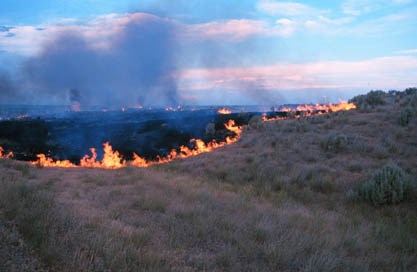
(Photo by Mike Munts) The fire season at Craters of the Moon National Monument extends from mid-June through mid-September. Research indicates that vegetation similar to that in the monument has burned about every 25 to 75 years during pre-European conditions. With the exception of areas in the northern portion of the monument, the vegetation is isolated into pockets by lava flows and cinder gardens. Fires burning in many of these small patches of vegetation would have little chance of spreading. The discontinuous fuels and low fuel loads in the monument have probably resulted in fire-free-intervals greater than those previously reported for similar vegetation types. The north end of the monument contains charred limber pine boles and sagebrush stems, set-back vegetation where rubber rabbitbrush has replaced the big sagebrush, and even-aged stands of aspen which indicate the presence of fire within the last 100 years. In general, the influence of fire at Craters of the Moon is consistent with other areas of the Snake River Plain. The effect of fire can be observed in almost all vegetation types. Fire has influenced the establishment of introduced cheat grass (Bromus tectorum) in much of the central and western portions of the Snake River Plain. Annual cheat grass has replaced native shrub species following fire and has resulted in the loss of significant sagebrush steppe habitat. In the higher elevation areas of the upper Snake River Plain, cheat grass has proven less competitive. Cheat grass is found throughout the monument but is not found in dominant stands. Observations thus far indicate that the stability and health of the monument’s vegetation communities aids in natural rehabilitation. Craters of the Moon National Monument fire management emphasizes the natural role of fire in the ecosystem while protecting sagebrush steppe habitats. Additional issues regarding resource preservation and protection, public safety, and land management policy and partnerships continue to be addressed. Craters of the Moon Wildland Fire Management Plan Current Fire Activity |
Last updated: December 8, 2017
